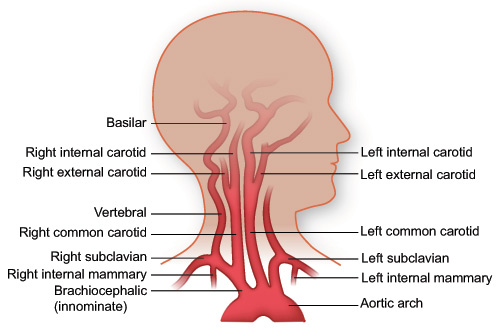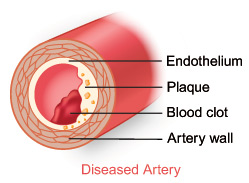Related terms: cerebrovascular disease, stroke, transient ischemic attack (TIA)
Carotid artery disease affects the vessels leading to the head and brain (cerebrovascular disease). Like the heart, the brain's cells need a constant supply of oxygen-rich blood. This blood supply is delivered to the brain by the 2 large carotid arteries in the front of your neck and by 2 smaller vertebral arteries at the back of your neck. The right and left vertebral arteries come together at the base of the brain to form what is called the basilar artery. A stroke most often occurs when the carotid arteries become blocked and the brain does not get enough oxygen.

Carotid artery disease increases the risk of stroke in 3 ways: 
- By fatty deposits called plaque severely narrowing the carotid arteries.
- By a blood clot becoming wedged in a carotid artery narrowed by plaque.
- By plaque breaking off from the carotid arteries and blocking a smaller artery in the brain (cerebral artery).
Who is at risk for carotid artery disease and stroke?
About every 4 minutes, somebody in the United States dies of a stroke. The older you are, the greater your risk of stroke, and more men than women have strokes. Stroke is the number 5 killer in the United States, and a leading cause of disability among older Americans.
See also on this site: Stroke
If you have carotid artery disease, you probably also have severe coronary artery disease or have a parent who died from coronary artery disease. So, the risk factors for carotid artery disease are similar to those for coronary artery disease:
- High levels of low-density lipoprotein cholesterol (bad cholesterol) and triglycerides in the blood.
- High blood pressure
- Diabetes
- Smoking
- Family history of coronary artery disease
- Obesity
- Lack of exercise
What are the symptoms of carotid artery disease?
Although there are no symptoms specific to carotid artery disease, the warning signs of a stroke are a good way to tell if there is a blockage in the carotid arteries. Transient ischemic attacks (TIAs) are one of the most important warning signs that you may soon have a stroke. Sometimes called "mini-strokes," TIAs are temporary episodes of headache, dizziness, tingling, numbness, blurred vision, confusion, or paralysis that can last anywhere from a few minutes to a couple of hours. See a doctor right away if you or someone you know has the symptoms of a TIA.
Other signs or symptoms of a carotid artery blockage may be
- Weakness or paralysis of your arm, leg, or face on one side of your body.
- Numbness or tingling of your arm, leg, or face on one side of your body.
- Trouble swallowing.
- Loss of eyesight or blurry eyesight in one eye.
- Dizziness, confusion, fainting, or coma.
- Sudden, severe headache with no known cause.
How is carotid artery disease diagnosed?
In most cases, doctors can tell if you have the disease during a normal checkup. Your doctor may ask if you have had symptoms of a stroke (muscle weakness or numbness, lightheadedness, or trouble talking or seeing). By placing a stethoscope over the carotid artery in your neck, your doctor can listen for a rushing sound, called a bruit (pronounced "brew-ee"). But, the results of this test can be misleading. Bruit sounds may not always be present, even when carotid artery disease is severe. Also, bruit sounds are sometimes heard when blockages are only minor.
Other diagnostic tools include
- Doppler ultrasound imaging, which uses sound waves to check blood flow and measure the thickness of your carotid arteries.
- Magnetic Resonance Angiography (MRA), which is a type of magnetic resonance imaging that uses harmless but powerful magnetic fields to give a detailed picture of the arteries in your brain.
- Oculoplethysmography, which measures the pulsation of the arteries in the back of your eye, as an indirect check for blockages in the carotid arteries.
- Arteriography and digital subtraction angiography (DSA), which takes X-ray pictures of the carotid artery after a special dye is injected into your bloodstream.
|
Doppler ultrasound or "echo" study |
How is carotid artery disease treated?
In addition to treating atherosclerosis or other underlying disorders, lifestyle changes, medicines, percutaneous interventions, or surgery may be needed to offset the effects of carotid artery disease and lower the risk of stroke.
Lifestyle Changes
Treatment for carotid artery disease includes lifestyle changes. The National Stroke Association recommends that you
- Quit smoking.
- Control high blood pressure, cholesterol, diabetes, and heart disease.
- Find out if you have heart rhythm problems, especially atrial fibrillation, which increases the risk of blood clots that can lead to stroke.
- Limit the amount of alcohol you drink. Experts say that moderate intake is an average of one to two drinks per day for men and one drink per day for women. One drink is defined as 1½ fluid ounces (fl oz) of 80-proof spirits, 4 fl oz of wine, or 12 fl oz of beer.
- Include exercise (such as 30 minutes of walking) in your daily activities.
- Use less salt in your food.
- Talk to your doctor about circulation problems that put you at risk for stroke.
- See a doctor right away if you have symptoms of stroke.
Medicines
Blood-thinning medicines (called anticoagulants) may be needed to prevent stroke. Blood-thinning medicines and aspirin have been shown to lessen the risk of stroke. In most cases, patients will need to take these medicines for the rest of their lives.
Percutaneous Interventions
Interventional cardiologists may perform carotid artery angioplasty to open clogged carotid arteries. They use a long, thin tube called a catheter that has a small balloon on its tip. They inflate the balloon at the blockage site in the carotid artery to flatten or compress the plaque against the artery wall.
Carotid angioplasty is often combined with the placement of a small, metal, mesh-like device called a stent. When a stent is placed inside of a carotid artery, it acts as a support or scaffold, keeping the artery open. Carotid angioplasty and stenting are usually performed in patients either because they are not candidates for the traditional surgery (carotid endarterectomy) or because the procedure is felt to be less risky than the traditional surgery.
Surgery
Carotid endarterectomy removes fatty plaque from neck arteries.
See also on this site:




